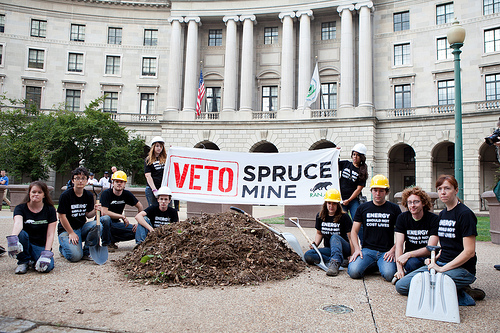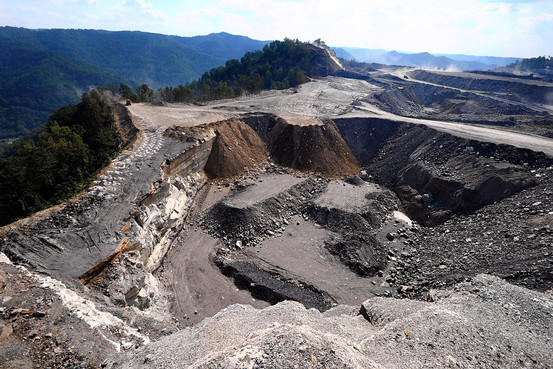Posted January 18, 2011
Working in the Mountain Justice movement as a socialist has had its trying moments. The movement was established in 2005 by a coalition of local Appalachians effected by the worst excesses of the coal industry and a much younger layer of environmentalist activists from outside the region itself. On one wing of the movement, there is a hard core dedicated to tactics of direct action and non-violent civil disobedience while, on the other, is a NGO-ized section of more bureaucratic organizations dedicated to incremental legal challenges to the practice of mountaintop removal coal mining–a particularly ruthless form of strip-mining. In between these are the actual working people of Appalachia whose hearts are frankly more with with direct action-oriented activists, and with good reason. Incremental legal challenges to the coal industry have mostly failed, especially in the context of the catastrophe that is befalling Appalachia.

It is in this context that the recent success of the Mountain Justice social movement in pressuring the EPA to veto the permit it had previously granted to the industry at the Spruce No. 1 mine in Logan County, West Virginia has inspired a great deal of hope in activists and residents of the beleaguered region. This comes on the heels of numerous mobilizations since 2005 by Mountain Justice activists and Appalachia residents which culminated this fall in a mobilization in Washington called “Appalachia Rising.”
I attended the Appalachia Rising mobilization with several other Solidarity members and allies from local environmentalist groups here in middle Tennessee. The development of the internal culture of this movement is stunning–the workshops, music, artistic expression and social gatherings all helped build the cohesion and commitment of the activists in a way that I had not experienced before. Following a day of political education, debate, art and cultural activities, there was a several thousand strong march through the streets of Washington. The most important event in this march, in my analysis, was the rally in front of the EPA building.
Mountain Justice activists had previously been informed that different elements within the EPA bureaucracy supported their efforts, but were constrained by the trappings of Washington officialdom. In this context, the pressure put on the bureaucracy directly has had an enormous impact on pushing it to act in the interests of the people of Appalachia–and in accordance with Federal law.

Enter the EPA’s very recent veto of the Spruce No. 1 mine permit. This has been a great victory for the movement, but only a single victory in a sea of devastation. Appalachia has suffered in ways that are unimaginable to many over the past 20 years (not to mention the previous years). Lean production methods led to a massive slashing of the coal mining workforce, leading to massive migration and economic deprivation. As the workers’ disappeared, productivity and profits skyrocketed under the new strip-mining regime. A large number of deep-mining workers were replaced by a small number of much better-paid explosive-experts, etc. whose loyalty to their industry is zealous to say the least.
The last attempt to reform the United Mine Workers–as dramatically captured in the film Harlan County, USA–resulted in violent intimidation and the murder of rank and file reform activists. Since then, the collusion between the United Mine Workers’ bureaucracy and the coal industry bosses has continued without serious interruption. Consequently, in this struggle for the Appalachian people the historic agent of social change has been taken out of the equation. The result has been a movement with bodies and will but no teeth in the form of strikes and other industrial actions.
The Mountain Justice movement emerged in 2005 after yet another accident from mountain-top removal coal mining led to the death of a young boy (he was sleeping in his bed with a bolder crashed through his house, not an uncommon occurence in the region). The movement consists of three camps a year (Spring, Summer, Fall) which involve internal development and usually end in some kind of coordinated action, as well as numerous organizations and grassroots coalitions dotting the region and its surrounding areas.
The movement has chased the financing of mountain-top removal coal mining from Bank of America to Chase Bank to PNC Bank and finally to a much more difficult foe: the Swiss giant UBS. UBS, as an investment bank, is not susceptible to the same kind of pressure as the other banks. The movement has also successful challenged local and state governments. In the case of Tennessee, the former Governor Bredesen took an astonishingly anti-MTR (mountain-top removal) stance in order to stave off the kind of problems government officials have had with activists in West Virginia and Kentucky (it remains to be seen whether the new Republican Governor Haslam will follow suit).
Once again, between the two wings of bureaucratic liberal NGOs and grassroots environmental activists stands the working-people of Appalachia–divided against their fellow workers’ in the coal industry itself. The blood, sweat and tears of organizing that resulted in the EPA veto may be just the beginning of more mobilizations and success. There is also a good chance that the united efforts of the coal industry and Tea Party-oriented politicians in the local, state and federal governments will succeed in either reversing the EPA’s decision or in preventing this from becoming a general trend of EPA enforcement of federal law.
Meanwhile, the migration out of this devastated region continues as jobs disappear and the environment turns toxic. Some residents can actually light their water on fire. Orange toxic streams dot the landscape. The headwaters of the drinking water of much of the Southern USA are being progressively poisoned with the valley fills. It is imperative that socialists join this fight and begin to advocate for putting the coal industry workers back in the fight.
